|
MUSIC FOR
THE ENGLISH LANGUAGE
ROMAN MISSAL
AN INTRODUCTION
For the forthcoming
English translation of the Roman Missal (sometimes
called the Sacramentary), the International
Commission on English in the Liturgy (ICEL) will offer
to the Conferences of Bishops of the English-speaking
world chants for everything that is set to music in
the Missale Romanum, editio typica tertia
(2002):
- The dialogues between the celebrant and the assembly
such as the Sign of the Cross (“In the name
of the Father, and of the Son, and of the Holy Spirit”)
and the Dismissal (“Go forth, the Mass is
ended”);
- Tones for singing the presidential prayers (Collect,
Prayer over the Offerings, Prayer after Communion)
with all prayer texts pointed for singing;
- The chants before and after the readings such
as “A reading from the book of…”
and “The Gospel of the Lord”;
- Separate tones for singing the First Reading,
Second Reading, and Gospel;
- The Universal Prayer or Prayer of the Faithful;
- The Preface Dialogue and Prefaces, including a
musical setting of every Preface;
- Full musical settings of Eucharistic Prayers
I, II, III and IV, and the concluding Doxology;
- Other elements such as the Kyrie, Gloria,
Creed, Sanctus, Agnus Dei, and Lord’s
Prayer;
- Chants for particular days and feasts such as
“Hosanna to the Son of David” on Palm
Sunday, the Universal Prayer and “Behold the
wood of the Cross” on Good Friday, the Exsultet
(Paschal Proclamation) at the Easter Vigil, antiphons
for the Feast of the Presentation of the Lord on
February 2nd, and the Proclamation of Easter and
Moveable Feasts for Epiphany.
- Some of the Latin chants will also be provided,
including the Sanctus, Pater noster, Agnus Dei,
and intonations for the Gloria and Credo.
A chant setting of the Greek Kyrie from Mass XVI
will also be provided.
In some cases, following the example of the Missale
Romanum, both simple and solemn settings have
been provided.
Principles
ICEL’s work in preparing chant settings of the
English translation has been guided by several principles:
- To preserve and recover the tradition of unaccompanied
singing in the Roman Rite, since the liturgy “is
given a more noble form when . . . celebrated solemnly
in song” (Second Vatican Ecumenical Council,
Constitution on the Sacred Liturgy Sacrosanctum
Concilium, 1963 [hereafter SC] 113);
- To facilitate “full and active participation
by all the people,” which is “the aim
to be considered before all else” (SC 14);
- To take full account of the accentuation of the
English language, since “the nature and laws
of each language must be respected” in the
adaptation of traditional melodies (Sacred Congregation
for Rites, Instruction on Music in the Liturgy Musicam
Sacram, 1967, 54);
- To retain vernacular chants now in use where
possible, since “there must be no innovations
unless the good of the Church genuinely and certainly
requires them” (SC 23).
The Commission’s musical
consultors have undertaken a detailed analysis of
the Latin settings, creating tables of accent patterns
and musical formulas. Likewise for the new English
translation, tables of the accent patterns have been
created, in order to arrive at the best solution where
the English text has accent patterns not found in
Latin. The musicians have found it helpful to look
at the work of other vernacular chant adaptations
such as Spanish, French, and German. German-language
scholarship has proven helpful, both because German-speaking
scholars began investigating vernacular chant adaptation
as early as the 1920s, and also because the German
language has some similarities to English, for example,
in the accent often falling on the final syllable
of a phrase. The musicians also examined the previous
work of English language chant adaptation in the liturgical
books of 1966, 1970, 1971, and 1973. With all this
in mind, their uppermost concern has been the actual
celebration of the liturgy by worshiping communities
and ministers.
Some of the Most Commonly
Sung Chants
Preface Dialogue
For the Preface Dialogue at the beginning of the Eucharistic
Prayer, the setting currently used in most of the
English-speaking world is retained, with appropriate
adjustments for the revised text:
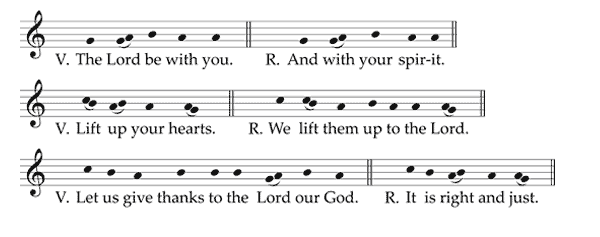
This current setting fits the
natural accentuation of the English text admirably.
Also, this melody is already well-known to many English-speaking
Catholics around the world.
The musicians considered and rejected
a setting of the Preface Dialogue based on the Latin
solemn tone (Graduale Romanum, 1974 [hereafter
GR] 809-810; Graduale Simplex, 1975 [hereafter
GS] 8):

This new melody might be difficult
for congregations; furthermore, it does not fit the
English text as well as the current setting. The current
and proposed setting, with its moderate ornamentation,
will work very well with the proposed new Preface
tone (presented further below).
For the congregational response
“It is right and just,” two other possibilities
were considered and rejected:

It was not considered advisable
to retain the opening on two As (left above) as the
current setting does, since the revised Preface tone
reintroduces the pattern of using only one A in all
such cases. It would be unwise to ask congregations
to learn a revised setting (see right above) with
just one note different from the familiar opening.
The solution was to start on C.
Doxology of the Eucharistic
Prayer

The opening phrase treats the
English text exactly as in the revised Preface tone.
This is preferable to retaining AC and CB note groups
on “through” and “with,” which
would result in unattractive repeated notes:

Note that the revised setting
stays on the reciting note C rather than cadencing
on “almighty Father,” as might have been
suggested by the current setting. The reason lies
in the syntax of the revised text, which calls for
a repetition of the first musical cadence on “Holy
Spirit” rather than on “almighty Father.”
It is felicitous that the full concluding cadence
of the revised Preface tone (see the next section)
is able to be used for “honor and glory.”
Preface
The current Preface tone is based on the Latin simple
Preface tone. The revised Preface tone will be slightly
more ornate, based in part on the Latin solemn Preface
tone with necessary adaptations for the English language.
(This new Preface tone will be similar to the tone
of the Easter Proclamation Exsultet.) Some
singers report that a slightly more ornate setting
is easier to sing because of its melodic
appeal in comparison to a less ornamented setting.
The Latin solemn Preface tone is more ancient, and
it was the sole tone in use for centuries, dating
back to the formative era of the liturgy. The simple
tone was derived from it in the 11th and 12th centuries.
Latin solemn Preface tone:

Latin simple Preface tone:

A single revised Preface tone is being proposed as
the English language Preface tone. Here it is illustrated
by the beginning of the Preface of Eucharistic Prayer
IV:

It has been considered preferable to follow the Latin
tone by having a single note A before the reciting
note C in all cases. The current Preface tone sometimes
has more than one anticipatory A, and other times
it begins directly on C. The revised English text
argues against this solution, for in some cases there
would need to be three or more anticipatory As, and
in some cases this would result in only one or two
syllables being left for the reciting note C. Once
the singer becomes familiar with the standard formula,
it should not be difficult to render the revised setting
convincingly and without distortion.
Note that the setting of “give
you thanks” accounts for two final accents (on
“give” and “thanks”), unlike
the Latin solemn Preface tone formula which only consults
one final accent. A more Latinate one-accent cadence
would have been:

But in this case, unlike the concluding
cadence formula (such as “under heaven as we
sing” above), a two-accent formula can be devised
for the sake of the English language. Although such
a two-accent formula never occurs in the Latin Prefaces,
it does in the Latin Exsultet:

Drawing on this “beata
nox” exception, the revised Preface tone
has a two-accent formula (final accent and secondary
accent) which treats the various English accent patterns
as follows:

The treatment of the concluding
cadence formula is well illustrated by comparing the
two excerpts below, both from the Preface of Eucharistic
Prayer IV. When the English text ends on an accented
syllable such as “sing” at the cadence,
the melodic formula must be abbreviated to a single
final A. But when the English text ends with a word
such as “ceasing,” a fuller melodic form
of the cadence is possible.
Cadence with final-syllable accent:
 Cadence
without final-syllable accent: Cadence
without final-syllable accent:
 In
this concluding cadence formula, textual considerations
determine when to move from the reciting note B to
begin the cadence formula, and whether or not to split
any of the two-note groups such as AG or GA. Compare
the following examples, all from the Preface of Eucharistic
Prayer IV. The first example below is the fullest
cadence formula, closest to the Latin solemn tone;
the others are slight modifications of it as called
for by the accentuation of the English text. In
this concluding cadence formula, textual considerations
determine when to move from the reciting note B to
begin the cadence formula, and whether or not to split
any of the two-note groups such as AG or GA. Compare
the following examples, all from the Preface of Eucharistic
Prayer IV. The first example below is the fullest
cadence formula, closest to the Latin solemn tone;
the others are slight modifications of it as called
for by the accentuation of the English text.
 Happily,
the three-note note group with quilisma of
the Latin tone will be retrieved in the Prefaces,
as at the end of the Preface in the example below
over “voice”: Happily,
the three-note note group with quilisma of
the Latin tone will be retrieved in the Prefaces,
as at the end of the Preface in the example below
over “voice”:

Congregational Chants
of the Order of Mass
Kyrie
The current English Kyrie setting will be
retained, both as a free-standing acclamation and
with a musical formula for added invocations:

After much experimentation, it
was agreed that the English text of the Kyrie,
with its very few syllables, does not lend itself
to a melodic adaptation from any of the Gregorian
chant melodies of GR or GS. The Kyrie printed
above as an alternative response (from GS 451: Setting
G) fits nicely with the modality of the chanted English
invocations. This Kyrie may also be sung
as a free-standing acclamation.
Gloria
A setting of the Gloria based on chant Mass
XV is being provided, with the hope that a common
setting will become known throughout the English-speaking
world. Because the Latin setting is not much more
than a formulaic tone, it was possible to take necessary
freedoms for the sake of the English text:

Creed
It is likely that an English setting of the Profession
of Faith based on Credo I of the GR
will be proposed. While it is true that the melody
of Credo III is better known, it seems preferable
to leave that familiar melody for use with the Latin
text in the hope that it will remain in use or come
to be used more widely in Latin.
Sanctus

This setting follows the Latin melody closely. There
would have been good reasons, based on natural English
accentuation, for placing a single note A on the second
syllable of “Holy,” as in the current
setting:

But it was decided to imitate
the Latin with its displaced accent more closely here,
in part because the Latin setting is likely to be
sung with great frequency by congregations in the
future, which argues for similarity between the Latin
and English settings.
Memorial Acclamation
The Memorial Acclamation settings apply the basic
modal melodic elements of the Latin Mortem tuam
(GR 810, GS 10) to the new
English translations:
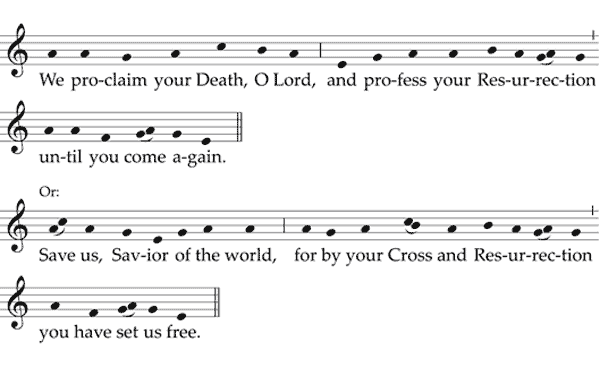
The Lord’s Prayer
The “Our Father” presents an interesting
pastoral conundrum. In the United States, a very successful
simplified setting with admirable treatment of the
English language is already widely used. Australia
has its own widely used setting based closely on the
Latin Pater noster, and other countries have
their own settings as well. Many would regret tampering
with an element of the reformed liturgy that the people
sing so well. Several possible pastoral solutions
were given serious consideration. ICEL could have
selected one from the many current settings of various
countries to include in the Roman Missal. Or ICEL
could have refrained from proposing a revised setting,
with the suggestion that each country retain what
is presently in use. After much consideration it was
decided to offer to all the Conferences of Bishops
a new setting based on the Latin Pater noster
(GR 812, GS 9-10). Each country
will examine the setting and decide whether or not
to introduce it, either alongside or as a replacement
for settings currently in use.
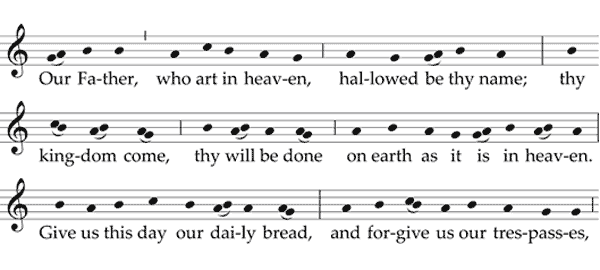
The first word of the revised
setting, “our” on G-A, is admittedly a
challenge, for it might come out as a two-syllable
“ow-er.” Still, it was decided to retain
this eminently memorable opening of the Latin setting,
rather than simplifying it by remaining on B for the
first three syllables, or by shifting the opening
notes to be G A-B B.
Within each phrase, the revised setting employs that
part of the respective Latin melody which best fits
the English text. “Hallowed be thy name,”
for example, draws on the corresponding Latin phrase
“sancificetur nomen tuum”:

The revised English setting employs
the notes from “sancti- . . . nomen tu-.”
This allows for a modally strong beginning on A and
G following the preceding phrase, and it lessens the
incorrect accent on “be” which would result
from a setting such as this:

Note groups C-B and A-B were used
for “kingdom,” both to avoid a modally
unstable run down the scale from C to G, which is
uncharacteristic of Latin settings (see below), and
also to balance the emphasis on the important words
“kingdom” and “will.” Similarly,
B rather than G is placed on “Give” so
as to avoid a run up the scale from G to C (see below).
“Forgive us” is not set with a run up
the scale on G A-B C (see below), which would overemphasize
“us.” The result of such careful use of
Latin formulas is an English setting that is as redolent
as possible of the Latin setting while fitting the
English text as naturally as possible. Other possible
solutions in the Lord’s Prayer were also rejected:

Agnus Dei
The Lamb of God setting is readily suggested by the
familiar Latin melody:

The treatment of “have mercy”
adds a note not found in Latin in order to have correct
stress on “mercy” rather than “have.”
Experimentation has shown that this added note on
“have” should be A rather than G.
Other Chants from the Order
of Mass
Sign of the Cross
Some of the other work of ICEL is presented here,
beginning with the first ministerial chant of the
Mass:

A literal adaptation such as this
was rejected:

This preserves the notes and the
note order of the Latin chant, but at the expense
of undue stress on “of.” The proposed
setting is similar to the current setting, which has
an abrupt cadence on the final accent “Son”:

It perhaps might have seemed preferable
to open directly on A, as in the current setting.
(If some priests find it easier to omit the initial
G in the new setting, it will hardly cause much harm.)
But it eventually proved necessary to begin on G to
parallel the revised prayer tone of the orations,
which is closely related to this chant.
Greeting
After examination of the Latin tone as well as the
current English tone, it was judged more advisable
to revise the current tone rather than develop a revised
setting based on the Latin. Here is the Latin, with
two rejected English solutions:


The first English version follows
the Latin quite literally; the second version shifts
the melodic elements to match the English accents.
Neither fits the English text as well as the Latin
or the current English setting. Furthermore, these
versions would be less likely to elicit the proper
response from the congregation, since they do not
echo the melody of the priest’s part. Here is
the proposed revision:

This setting uses the modal elements
of the current setting, with adjustment for the revised
text. A more literal following of the current setting
would have been:
Current setting:

Rejected solution:

This is an inadequate solution
on grounds of accentuation of the text as well as
the establishment of stable modal centers. The two
syllables on “also” in the current translation
enabled the modal center of A to be established solidly.
But with the new text, the rejected solution would
have led to unstable rapid alternation between G and
A.
Reading Tones
A nice addition to the English Missal will be newly
developed reading tones, one for each of the three
readings of the Mass. They are all based on the Latin
models, with necessary adjustments for natural rendition
of the English text. Here is the Epistle tone:
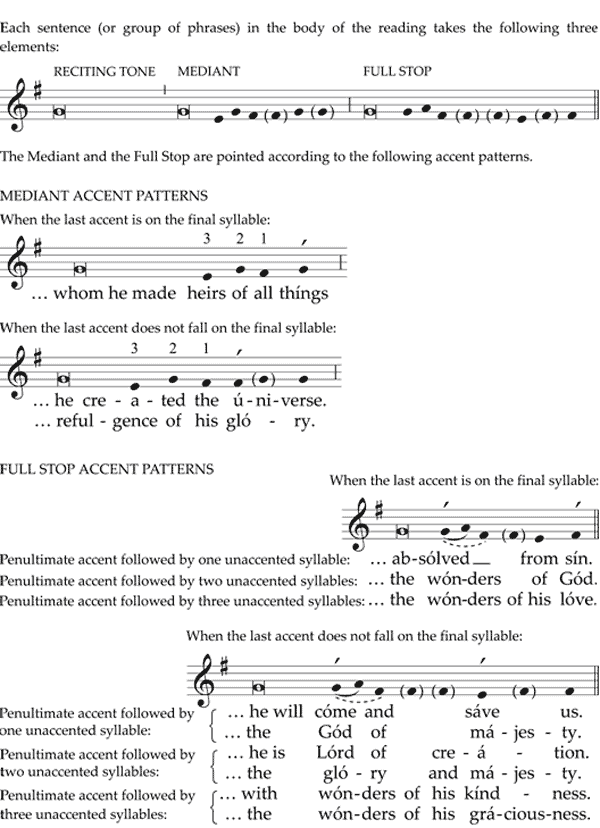
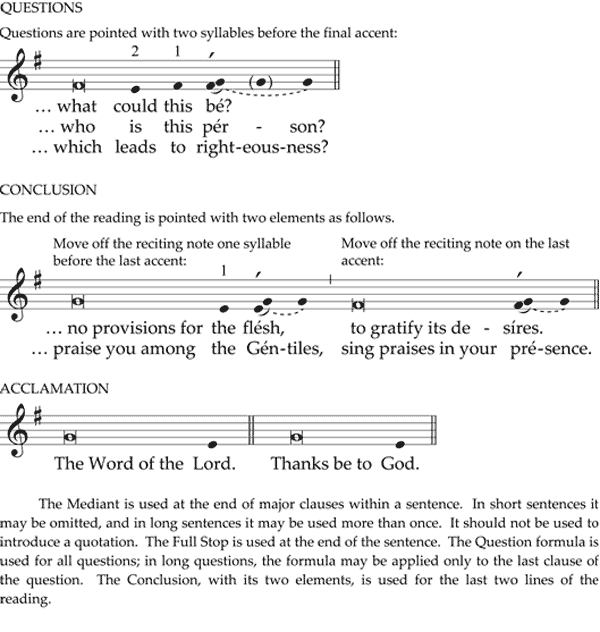
Because English has so many accent
patterns not found in Latin, it is necessary to have
a procedure and explanation as complete as this. When
one wishes to sing a reading, it will be necessary
to notate it entirely ahead of time, and the above
explanation is intended to show how to do this. Here
is the beginning of the Second Reading for the First
Sunday of Advent, Year A, in two of the Scripture
translations currently in use:



Layout and Notation
Layout and notation play an important
role in facilitating the sung rendition of liturgical
texts. ICEL has developed an attractive five-line
notation that facilitates ease of singing and makes
clear the primacy of the text. This notation is considered
to be integral to the new English language chant settings.
- Hyphens between syllables are used for clarity
at melodic cadences;
- White notes are used only for reciting tones;
otherwise, black notes without stems are used in
order not to imply equalist rhythms;
- Notes in note groups are spaced close together
rather than evenly spaced in order to make clear
the syllables to which they are subordinate;
- Slurs to mark note groups are placed under the
notes so as to be closer to the text;
- Notes and note groups are generally centered over
the entire syllable rather than over the vowel;
- A black note on the same pitch as the reciting
tone is used only over an accented syllable at the
beginning of the cadence formula;
- Liquescents and episemas are
not used;
- The quilisma is used only in the Preface
sung by the celebrant, not in congregational chants.
In the music to be provided to
the Conferences of Bishops, ICEL seriously considered
employing the venerable four-line square note notation
of the Latin chant books. Once one learns the medieval
notation, which does not take long, it is in some
ways easier to read than modern five-line notation.
But pastoral considerations argued against this approach.
There is danger that the traditional four-line notation
would pose a practical hindrance and psychological
barrier for some singers. The uppermost goal must
be to enable sung liturgy.
Though a standard G clef (without
accidentals) is used with this five-line notation,
it is not intended to suggest an absolute pitch, but
rather, as in four-line notation, relative pitch,
to accommodate various ranges of voices that will
be singing these chants. Recordings of this music
at different pitches will eventually be made available
on line free of charge on various Web sites. A celebrant,
for example, will be able to click on the text of
the Sunday Preface to be chanted and hear a recording
of it. Furthermore, composers will be able to provide
their own accompaniments (at more than one pitch)
of people’s parts such as the Gloria,
Creed, Sanctus, Memorial Acclamations, and
Agnus Dei.
It is a daunting responsibility to prepare liturgical
books for the liturgy, which is “a sacred action
surpassing all others” (SC 7). ICEL
hopes that its efforts will help the people of God
to worship worthily, and thereby achieve the purpose
of the liturgy, which is the sanctification of people
and the glorification of God (see SC 10).
For access to the music discussed in this report,
please click here
and enter the username and password provided by your
national liturgical office.
Introduction
to the Music of the Forthcoming English Language Roman
Missal © 2009, International Committee on
English in the Liturgy, Inc. (ICEL); excerpts from
the English translation, musical settings, and music
engraving of The Roman Missal © 2009,
ICEL. All rights reserved. This article (text and
music) must be reproduced without alteration.
|